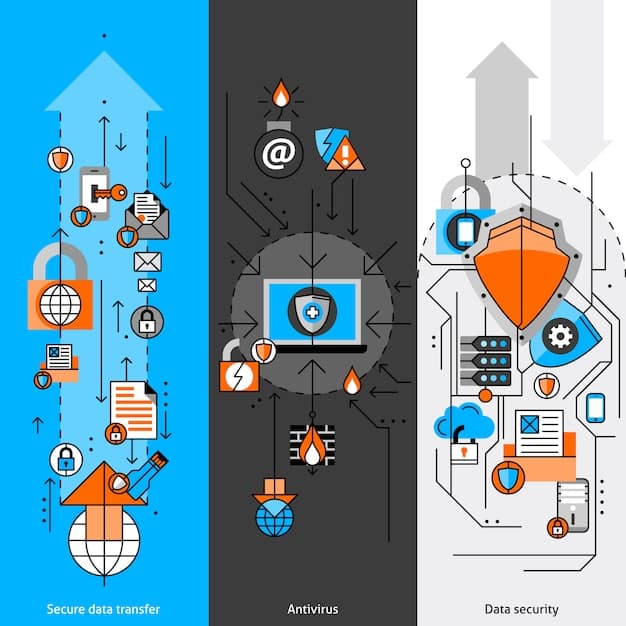The Future of Online Privacy: Navigating the Next 5 Years

The future of online privacy in the next 5 years will likely involve advancements in data protection technologies, stricter regulations like GDPR, and increasing consumer awareness of privacy rights, driven by growing concerns over data breaches and misuse.
The digital landscape is constantly evolving, and with it, so are the threats to our personal data. Understanding the future of online privacy: what to expect in the next 5 years is crucial for protecting ourselves in an increasingly interconnected world.
Understanding the Current State of Online Privacy
Before diving into future predictions, it’s essential to grasp the current state of online privacy. This involves recognizing the existing challenges and the frameworks that are already in place to protect our digital information.
Currently, online privacy is a complex landscape shaped by technological advancements, data collection practices, and regulatory efforts. Understanding these elements is the first step in navigating the ongoing challenges.
Major Privacy Regulations
Several regulations worldwide aim to protect user data. These laws often include stricter requirements for data consent, transparency, and accountability among organizations that handle personal information.
- GDPR (General Data Protection Regulation): A European Union law that sets stringent standards for data protection and privacy.
- CCPA (California Consumer Privacy Act): A state law in California that grants consumers various rights over their personal data.
- Other Regional Laws: Various other countries and states are implementing or considering similar laws to enhance online privacy.
Prevailing Threats to Online Privacy
Various threats continue to jeopardize online privacy, ranging from sophisticated hacking to data collection practices by tech companies. Understanding these threats is vital for taking appropriate protective measures.
- Data Breaches: Unauthorized access to sensitive data, often resulting in identity theft and financial loss.
- Tracking and Profiling: The collection and analysis of online behavior to create detailed consumer profiles, often without explicit consent.
- Surveillance: Government and corporate monitoring of user activities, raising significant privacy concerns.

In conclusion, understanding the current state of privacy requires a look at both the regulations in place and the threats continually facing our data. As technology evolves, so must our awareness and protective measures.
Anticipated Technological Advancements and Their Impact
Technological advances will play a pivotal role in the future of online privacy. From improving encryption methods to developing privacy-enhancing technologies (PETs), advancements are poised to reshape how we manage and protect our data.
The world of technology is continuously developing, with each new innovation leading to potential shifts in data protection and security. Understanding the potential impacts will be key for anyone seeking digital privacy in the new decade.
Advances in Encryption Technology
Encryption techniques are constantly evolving to provide more secure methods of data protection. Quantum-resistant encryption, homomorphic encryption, and end-to-end encryption are all promising technologies.
Here are some potential encryption solutions:
- Quantum-Resistant Encryption: Encryption algorithms designed to withstand attacks from future quantum computers.
- Homomorphic Encryption: Allows computations to be performed on encrypted data without needing to decrypt it first.
- End-to-End Encryption: Ensures that only the sender and recipient can read the messages, preventing eavesdropping.
The Rise of Privacy-Enhancing Technologies (PETs)
PETs are technologies designed to minimize data collection and maximize privacy. These might include differential privacy, federated learning, and secure multi-party computation.
PETs cover the following areas:
- Differential Privacy: Adds statistical noise to datasets to prevent the identification of individual data points.
- Federated Learning: Trains machine learning models across multiple decentralized devices, minimizing the need to centralize data.
- Secure Multi-Party Computation: Allows multiple parties to compute a function on their combined data without revealing their own individual data.

In summary, technological advances will likely provide more robust methods for safeguarding personal data. Both improvements in encryption and the rise of PETs will contribute to enhanced online privacy.
Evolving Regulations and Legislation
Regulatory bodies worldwide are working to address the shortfalls of existing data protection laws. It is anticipated that the next five years will see the emergence of stricter and more comprehensive legislation that reflects the changing digital landscape.
In an era marked by increasingly complex data practices, regulations and legislation play a fundamental role in defining what is acceptable concerning privacy rights. Expect upcoming mandates to provide broader protections for all.
Expected Updates to GDPR and CCPA
The General Data Protection Regulation (GDPR) and the California Consumer Privacy Act (CCPA) may see amendments to address new challenges and close loopholes. These updates could extend the scope of data protections and increase penalties for non-compliance.
These may include:
- Expanding Data Rights: Providing consumers with greater control over their personal data and how it is used.
- Strengthening Enforcement: Increasing the resources and authority of regulatory bodies to penalize organizations that violate privacy laws.
- Defining Data Usage: Clarifying acceptable methods of data collection and its proper use, thus reducing ambiguities.
Global Trends in Privacy Legislation
Many countries are adopting or considering data protection laws similar to GDPR and CCPA. These legislative actions reflect a growing international consensus on the importance of online privacy.
Global trends include:
- Adoption of GDPR-like Laws: Countries drawing inspiration from GDPR to create their own, tailored regulations.
- Cross-Border Data Transfer Rules: Implementing rules to safeguard personal data when transferred across international borders.
- Harmonization: Working towards a more unified international framework for data protection to simplify compliance for global organizations.
In conclusion, the evolution of regulations and legislation indicates a growing international commitment to online privacy. These developments will likely shape data protection practices and impact how organizations manage personal information.
The Growing Consumer Awareness and Its Influence
Consumers are becoming increasingly aware of their digital rights and the risks to their online privacy. This increased awareness is driving demand for more transparent data practices and better privacy tools.
As data breaches become more frequent and data usage practices become more overt, the role of informed digital citizens in promoting privacy is expanding. Consumer awareness is a driving factor in promoting online data security.
Demand for Transparency and Control
Consumers are demanding greater transparency from organizations regarding how their data is collected, used, and shared. They also seek more control over their personal information, including the right to access, correct, and delete it.
This demand includes:
- Clear Privacy Policies: A heightened expectation for accessible, easy-to-understand explanations of data practices.
- Data Control Tools: Desire for tools that allow consumers to directly manage their data and privacy settings.
- Opt-Out Options: Requirement for explicit options to opt out of data collection and targeted advertising.
Adoption of Proactive Privacy Measures
Many consumers are taking proactive steps to protect their online privacy, such as using VPNs, ad blockers, and privacy-focused browsers. They are also becoming more selective about the apps and services they use.
These protective measures include:
- Using VPNs: Virtual Private Networks encrypt internet traffic and hide IP addresses, enhancing anonymity.
- Installing Ad Blockers: Tools that block intrusive ads and prevent tracking by advertisers.
- Choosing Privacy-Focused Browsers: Browsers designed with integrated features to prevent tracking and enhance privacy.
In conclusion, increasing consumer awareness is fueling a demand for more robust data protection. As consumers become more proactive in protecting their online privacy, organizations will be forced to prioritize transparency and consumer control.
The Role of AI and Machine Learning in Privacy
Artificial intelligence (AI) and machine learning (ML) have a dual role in online privacy. While they can enhance privacy by detecting and preventing data breaches, they also pose risks due to their ability to analyze and infer sensitive information from large datasets.
AI is becoming a progressively integrated technology in modern digital services. Understanding its role is vital as technology continues to shape digital security.
AI for Privacy Protection
AI can be used to automate privacy compliance tasks, detect and prevent data breaches, and enhance data anonymization techniques. Machine learning algorithms can identify abnormal behavior and potential security threats.
AI offers great value by:
- Automating Compliance: Streamlining the process of adhering to privacy regulations and ensuring data practices align with mandated standards.
- Detecting Data Breaches: Identifying irregular activities and rapidly responding to potential security incidents.
- Enhancing Anonymization: Masking sensitive information in datasets to protect individuals’ identities while preserving data utility.
AI for Privacy Invasion
AI can also be used to infer sensitive information from seemingly innocuous data. This can lead to privacy violations, especially when combined with large datasets and advanced analytics.
Here are some risks:
- Inference of Personal Attributes: Revealing sensitive traits or preferences based on seemingly non-personal data points.
- Facial Recognition Challenges: Identifying individuals without consent using facial recognition technology and vast databases.
- Predictive Policing: Using data analysis to predict criminal behavior, potentially leading to biased targeting and privacy infringements.
In conclusion, AI and machine learning can either enhance or undermine online privacy, depending on how they are used. It is essential to develop ethical guidelines and regulations to ensure that AI is used responsibly and in a way that respects privacy.
Preparing for a Privacy-Centric Future
Preparing for a privacy-centric future requires adopting a strategic approach that balances technological innovation with ethical considerations. This involves fostering a culture of privacy within organizations and empowering individuals to protect their own data.
To properly adapt to a world becoming more aware of digital security demands, a mix of preparation, education, and ethical guidelines are necessary.
Building a Privacy-First Culture in Organizations
Organizations need to prioritize privacy in their design processes and data practices. This includes implementing privacy-by-design principles and conducting regular privacy impact assessments.
To achieve this, they can:
- Implement Privacy-by-Design: Integrating privacy considerations into the earliest stages of product and service development.
- Conduct Impact Assessments: Regularly evaluating the privacy implications of new projects and technologies.
- Train Staff: Educating employees on privacy best practices and their roles in protecting personal data.
Empowering Individuals to Protect Their Data
Individuals need to learn how to protect their own online privacy and demand accountability from organizations. This includes using privacy tools, understanding privacy policies, and exercising their data rights.
To take control of their online presence, individuals must:
- Use Privacy Tools: Employ VPNs, ad blockers, and secure browsers to protect their data and anonymity.
- Understand Policies: Read and comprehend privacy policies before using online services to know how their data is handled.
- Exercise Data Rights: Utilize their rights to access, correct, and delete their personal data as granted by privacy regulations.
| Key Point | Brief Description |
|---|---|
| 🛡️ Stronger Regulations | GDPR and CCPA updates, plus new global laws, will offer more data protection. |
| 🔒 Encryption Advances | Quantum-resistant and homomorphic encryption will enhance data security. |
| 🧑💻 Consumer Awareness | Higher consumer awareness will drive the demand for clear, fair data practices. |
| 🤖 AI and Privacy | AI could protect or invade privacy; ethical rules are crucial. |
FAQ
▼
The largest threats include data breaches leading to identity theft, pervasive tracking by websites and advertisers, and government surveillance of personal information.
▼
PETs minimize data collection and enhance privacy by techniques like differential privacy, federated learning, and secure multi-party computation.
▼
Individuals can use VPNs, ad blockers, and privacy-focused browsers. Also, read and understand privacy policies before using online services.
▼
Yes, GDPR and CCPA are likely to remain important and may see updates to address new challenges and enhance data protection.
▼
AI can both protect and invade privacy. AI-powered tools can identify breaches, but they can also analyze data to infer sensitive information.
Conclusion
The future of online privacy will greatly depend on the interplay of technological advancements, regulatory developments, consumer awareness, and ethical considerations. By anticipating these changes and adopting proactive measures, both organizations and individuals can navigate the increasingly complex digital landscape while safeguarding personal data and privacy rights.





